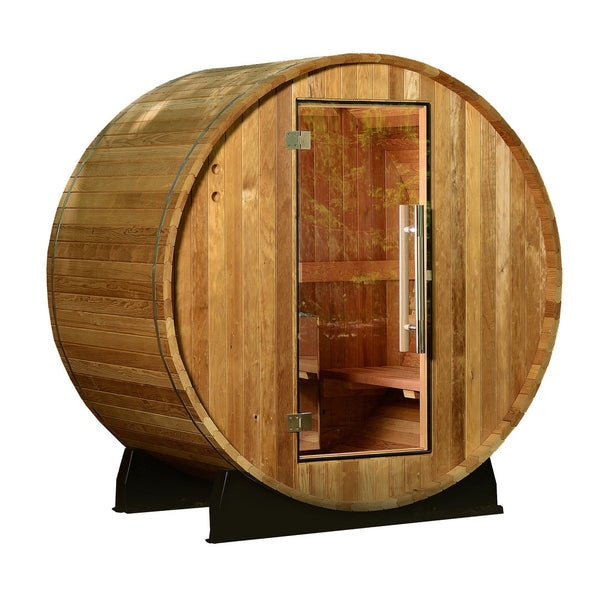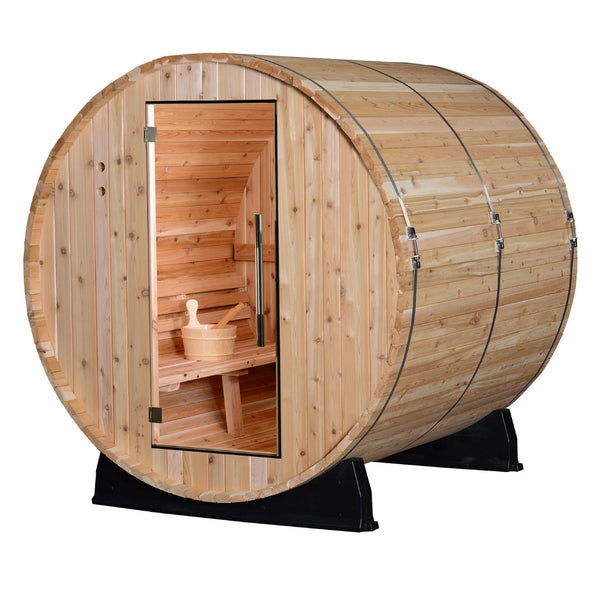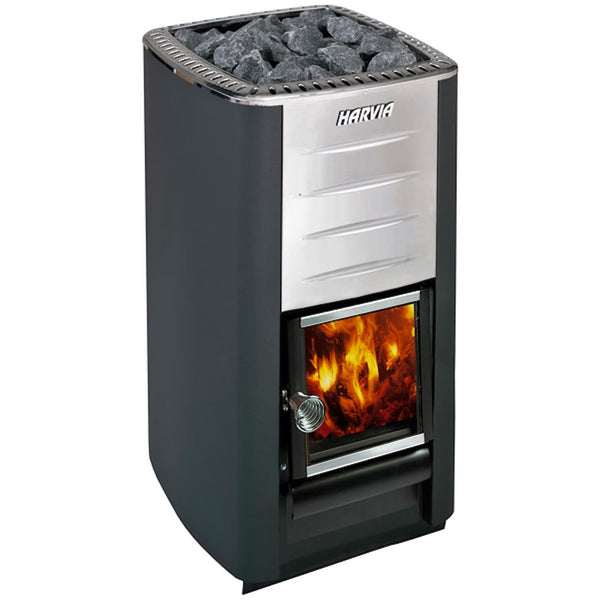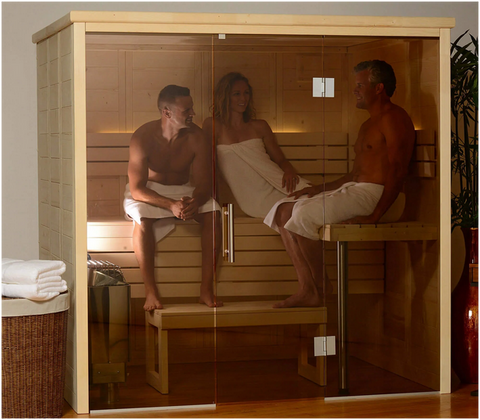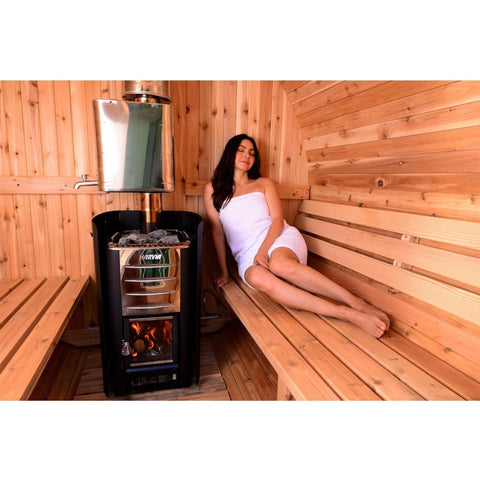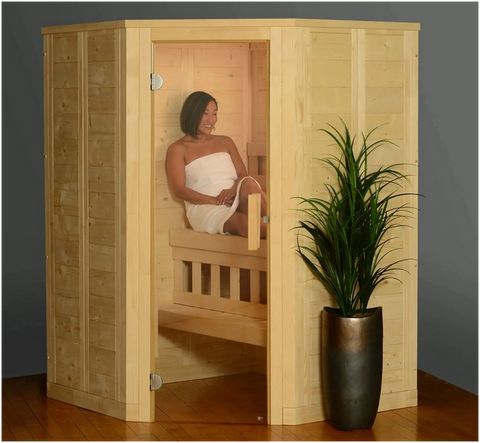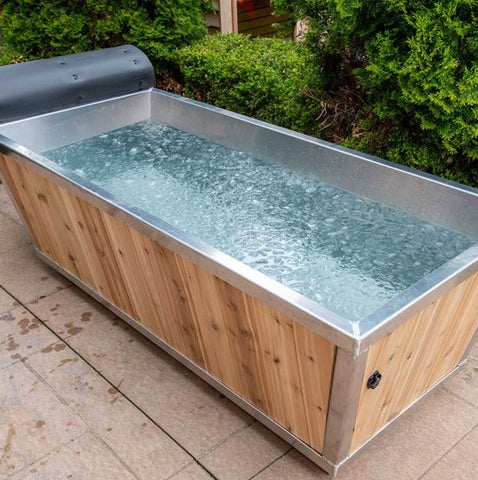
The concept of using a sauna for weight loss is rooted in the physiological responses that occur in the body during a sauna session. When you enter a sauna, the high temperature causes your body to heat up, which triggers several reactions.
The concept of using a sauna for weight loss is based on the physiological responses to heat exposure, including increased heart rate, sweating, potential fat cell breakdown, and improved metabolic health.
Increase in Heart Rate
Your heart rate increases. This cardiovascular response is similar to the one experienced during moderate exercise. The increased heart rate can lead to a higher metabolic rate, which means your body burns calories at a faster pace. However, it’s important to note that the calorie burn in a sauna, while elevated, may not be as significant as that achieved through active exercise.
Promote Cooling Down
The heat causes your body to sweat as a means to cool down. Sweating leads to a loss of water weight. While this can result in immediate weight loss, it’s temporary and the weight is typically regained once you rehydrate.
Relaxation and Detox
Spending time in a sauna is primarily beneficial for detoxification and relaxation. The sauna's warm environment helps your body to sweat out toxins and can provide a feeling of well-being, but for fat loss, other methods are more effective.
Improve Insulin Sensitivity
Sauna use may also lead to improved insulin sensitivity and a reduction in levels of inflammation in the body. These factors can indirectly support weight loss and overall metabolic health.
However, it’s important to note that while sauna use can complement a weight loss regimen, it should not replace a balanced diet and regular exercise.
How Does a Sauna Help in Losing Weight?
Saunas can potentially aid in weight loss through several mechanisms, primarily related to the body’s physiological responses to heat exposure.
Increased Metabolic Rate
The heat from a sauna raises the body’s core temperature, which in turn increases the heart rate. This is similar to the increase in heart rate that occurs during physical exercise.
The elevated heart rate can lead to an increased metabolic rate, which means the body burns calories at a faster pace.
Sweating and Fluid Loss
Saunas induce profuse sweating, which can lead to a temporary loss of body weight due to fluid loss.
It’s important to note that this weight loss is not permanent and will be regained once the body is rehydrated. However, the process of sweating and rehydration can potentially stimulate the metabolism, contributing to calorie burning.
Improved Blood Circulation
The heat from a sauna can improve blood circulation, similar to the effect of low to moderate exercise. Improved circulation can help in the breakdown of fat deposits and the removal of waste products from the body, which may aid in weight loss.
Stress Reduction
Saunas can also help reduce stress levels. High stress levels can lead to weight gain or difficulty losing weight, particularly due to the hormone cortisol, which can promote fat storage in the body. By helping to reduce stress, saunas may indirectly support weight loss efforts.
It’s important to note that while these mechanisms suggest that saunas could aid in weight loss, sauna use should not replace a balanced diet and regular exercise. Sauna use can complement a healthy lifestyle but is not a standalone solution for weight loss.
The weight loss associated with sauna use is often temporary, primarily due to fluid loss rather than fat loss.
What is the Science Behind Sauna Use and Weight Loss?
The science behind sauna use and weight loss is multifaceted, involving several physiological processes that occur when the body is exposed to the high temperatures of a sauna.
Promotes a Cooling Response
The heat from the sauna causes the body’s core temperature to rise. This triggers a cooling response, which includes an increase in heart rate and metabolic rate.
The increase in metabolic rate can lead to an increase in calorie expenditure, which, over time, can contribute to weight loss.
Leads to Sweating
The heat exposure in a sauna can lead to substantial sweating. Sweating is the body’s way of cooling down, and it also helps to eliminate toxins from the body.
While the weight loss from sweating is primarily water weight and is quickly regained once the individual rehydrates, regular sauna use can help to reduce water retention, contributing to a leaner appearance.
Improved Insulin Sensitivity
Some research suggests that regular sauna use can lead to improvements in insulin sensitivity and a reduction in levels of inflammation in the body.
Both of these factors can play a role in weight management. Improved insulin sensitivity can help the body to more effectively process carbohydrates, reducing the likelihood of weight gain.
Meanwhile, reduced inflammation can support overall health and well-being, which can indirectly support weight loss efforts.
It’s important to note that while these physiological processes can support weight loss, sauna use should not be seen as a standalone solution for weight loss. It is most effective when combined with a balanced diet and regular physical activity.
The weight loss associated with sauna use can vary greatly between individuals, and more research is needed to fully understand the potential weight loss benefits of sauna use.
The Effectiveness and Safety of Using Sauna for Weight Loss
How Much Weight Can You Lose in a Sauna?
The amount of weight one can lose in a sauna varies greatly depending on several factors such as the individual’s body composition, the duration of the sauna session, and the temperature of the sauna.
In a typical sauna session, an individual can lose approximately 1 pound of water weight. This weight loss is primarily due to the body’s increased sweat production in response to the heat of the sauna. Sweating is the body’s natural cooling mechanism and can result in a significant loss of body water.
However, it’s important to note that this weight loss is temporary and will be regained once the individual rehydrates. This is because the weight lost in a sauna is primarily water weight, not body fat.
While sauna use can result in immediate weight loss on the scale, it does not result in long-term. The body’s rate of fat burning does not significantly increase in a sauna, so any weight loss beyond water weight is likely to be minimal.
Extended sauna sessions can pose health risks, including dehydration and heat exhaustion. Therefore, it’s recommended to limit sauna sessions to 10-15 minutes at a time, especially for beginners.
Always remember to rehydrate after a sauna session to replace the water lost through sweating.
What are the Potential Risks and Side Effects of Using a Sauna for Weight Loss?
The use of a sauna for weight loss, while beneficial for some, can also pose potential risks and side effects. It is crucial to be aware of these before starting a sauna weight loss regimen.
Dehydration
Saunas cause the body to sweat, which can lead to dehydration if not properly managed. This can result in symptoms such as dizziness, fainting, and in severe cases, heat stroke. It is essential to drink plenty of water before and after a sauna session to replenish lost fluids.
Electrolyte Imbalance
Along with water, the body also loses electrolytes through sweat. This can lead to an imbalance, causing symptoms like muscle cramps, fatigue, nausea, and irregular heartbeat. Consuming electrolyte-rich drinks or foods can help maintain balance.
Overheating
Extended periods in a sauna can lead to overheating, potentially causing heat exhaustion or heat stroke. Symptoms include headache, nausea, rapid heartbeat, and confusion. It’s important to limit sauna sessions to recommended durations and to exit immediately if feeling unwell.
Blood Pressure Changes
Saunas can cause temporary drops in blood pressure, which can be risky for individuals with low blood pressure or cardiovascular conditions. Conversely, the body’s attempt to cool down can also cause a spike in blood pressure, posing risks for those with hypertension.
Skin Irritations
Some individuals may experience skin irritations or burns from the high heat in a sauna. It’s recommended to sit on a towel and avoid direct contact with heated surfaces.
Below is a table of the potential risks associated with saunas, their symptoms, and prevention strategies.
|
Potential Risk |
Symptoms |
Prevention |
|
Dehydration |
Dizziness, fainting, heat stroke |
Drink plenty of water before and after sauna |
|
Electrolyte Imbalance |
Muscle cramps, fatigue, nausea, irregular heartbeat |
Consume electrolyte-rich drinks or foods |
|
Overheating |
Headache, nausea, rapid heartbeat, confusion |
Limit sauna sessions, exit if feeling unwell |
|
Blood Pressure Changes |
Dizziness, fainting (low BP); headache, shortness of breath (high BP) |
Consult with a doctor before using a sauna |
|
Skin Irritations |
Redness, itching, burns |
Sit on a towel, avoid direct contact with heated surfaces |
It’s always advisable to consult with a healthcare provider before starting a sauna weight loss regimen, especially for individuals with pre-existing health conditions.
|
Did you know? There used to be a World Sauna Championships held in Finland, where participants competed to endure the longest time in a sauna. However, due to health concerns, the event was discontinued in 2010. |
How Often Should You Use a Sauna for Weight Loss?
Determining the frequency of sauna use for weight loss depends on several factors, including individual health status, tolerance to heat, and specific weight loss goals.
Regular sauna sessions can potentially aid in weight loss by increasing the metabolic rate and promoting sweating, which can help the body burn calories. However, it’s important to note that the weight loss experienced immediately after a sauna session is primarily due to fluid loss through sweating, and not necessarily fat loss.
The frequency of sauna use for weight loss can vary widely among individuals. Some people may find benefit in daily sauna sessions, while others may opt for three sessions per week.
Here are some general guidelines to consider:
- Start Slowly: If you’re new to using a sauna, start with shorter sessions of around 10-15 minutes at a time. Gradually increase the duration and frequency of your sessions as your body adapts to the heat.
- Listen to Your Body: Pay attention to how your body responds to the heat. If you feel dizzy, lightheaded, or uncomfortable, it’s a sign that you should leave the sauna and cool down.
- Stay Hydrated: Sauna use can lead to significant fluid loss through sweating. It’s crucial to drink plenty of water before, during, and after your sauna session to prevent dehydration.
- Combine with Exercise: For optimal weight loss results, consider combining sauna use with regular physical exercise. Some people find that a sauna session after a workout can help enhance recovery and relaxation.
- Consult a Healthcare Provider: If you have any health conditions or concerns, it’s best to consult with a healthcare provider before starting a regular sauna regimen for weight loss.
While sauna use can complement a weight loss program, it should not replace a balanced diet and regular physical activity. The key to sustainable weight loss is a healthy lifestyle that includes a balanced diet, regular physical activity, adequate sleep, and stress management.
What Should You Do Before and After Using a Sauna for Weight Loss?

Before using a sauna for weight loss, there are several steps you should take to ensure your safety and maximize the effectiveness of your session:
- Hydrate: Drink plenty of water before entering the sauna. The heat can cause you to sweat profusely, which can lead to dehydration if you’re not properly hydrated beforehand.
- Eat a light meal: Consuming a light meal or snack before your sauna session can provide your body with the energy it needs to withstand the heat. However, avoid eating a heavy meal as it can cause discomfort and hinder the sweating process.
- Wear appropriate clothing: Wear light, breathable clothing or a bathing suit. Avoid heavy clothing that can inhibit sweating and make you uncomfortably hot.
- Remove jewelry: Metal can become hot in the sauna and potentially cause burns, so it’s best to remove any jewelry before entering.
- Shower: Taking a quick shower before entering the sauna can help open your pores and kickstart the sweating process.
After your sauna session, there are also several steps you should take to aid recovery and enhance the weight loss benefits:
- Rehydrate: Immediately after your sauna session, drink plenty of water or a sports drink to replenish the fluids and electrolytes lost through sweating.
- Cool down: Allow your body to cool down gradually. Avoid jumping into a cold shower immediately after leaving the sauna, as the sudden temperature change can be a shock to your system.
- Eat a nutrient-rich meal: Consuming a meal rich in nutrients after your sauna session can help replenish your body and aid in recovery. Focus on lean proteins, fruits, vegetables, and whole grains.
- Rest: Give your body time to recover after a sauna session. This is especially important if you’re new to using a sauna, as your body may not be accustomed to the heat.
- Monitor your body: Pay attention to how your body feels after using the sauna. If you feel dizzy, lightheaded, or unwell, it may be a sign that you’re dehydrated or that the sauna was too hot. If these symptoms persist, seek medical attention.
Can You Use a Sauna for Weight Loss During Pregnancy?
The use of a sauna for weight loss during pregnancy is a topic that requires careful consideration due to the potential risks involved.
Pregnancy induces several physiological changes in the body, including an increase in body temperature. The additional heat from a sauna can further elevate the body’s core temperature, which may pose risks to both the mother and the developing fetus.
Research suggests that exposure to high temperatures can increase the risk of certain birth defects. Therefore, many health professionals advise pregnant women to avoid activities that significantly raise their body temperature, including the use of saunas.
However, some studies indicate that short, infrequent sauna sessions may be safe during pregnancy, provided the body’s core temperature does not rise excessively.
Here are some guidelines for pregnant women considering sauna use:
- Consult a healthcare provider: Before using a sauna, pregnant women should consult their healthcare provider to discuss potential risks and benefits.
- Monitor body temperature: If given the green light to use a sauna, it’s crucial to monitor body temperature and avoid letting it rise above 95 degrees Fahrenheit (35 degrees Celsius).
- Limit sauna sessions: Pregnant women should limit their sauna sessions to no more than 10 minutes at a time.
- Stay hydrated: It’s essential to stay well-hydrated before, during, and after a sauna session to prevent dehydration, which can be harmful during pregnancy.
- Listen to your body: Pregnant women should pay close attention to how they feel during a sauna session. If they start to feel dizzy, nauseous, or uncomfortable in any way, they should leave the sauna immediately.
While sauna use can potentially aid in weight loss, its use during pregnancy should be approached with caution. Pregnant women should always consult with a healthcare provider before starting any new regimen for weight loss, including sauna use.
Can Using a Sauna Replace Regular Exercise for Weight Loss?
The question of whether using a sauna can replace regular exercise for weight loss is a complex one. While both activities can contribute to weight loss, they do so in different ways and offer distinct benefits and drawbacks.
Weight Loss from Saunas
Saunas promotes weight loss primarily through the process of sweating. The heat in a sauna increases the body’s core temperature, which in turn increases heart rate and metabolism, similar to the effects of moderate exercise.
This process can lead to temporary weight loss, primarily due to loss of water weight through sweating. However, this weight is typically regained once the individual rehydrates.
Weight Loss from Exercises
Regular exercise promotes weight loss by burning calories and building muscle, which can increase the body’s resting metabolic rate and lead to sustained weight loss over time.
Exercise also offers numerous other health benefits, including improved cardiovascular health, increased strength and flexibility, and improved mental health.
Here are some key points of comparison between sauna use and regular exercise for weight loss:
|
Aspect |
Sauna |
Regular Exercise |
|
Mechanism of weight loss |
Primarily through loss of water weight due to sweating |
Through burning calories and building muscle |
|
Duration of weight loss |
Typically temporary, weight is regained upon rehydration |
Can be sustained over time with regular exercise |
|
Additional health benefits |
Can aid in relaxation and stress relief, may improve skin health |
Improves cardiovascular health, increases strength and flexibility, improves mental health |
|
Risks |
Overheating, dehydration, can be unsafe for individuals with certain health conditions |
Risk of injury, can be challenging for individuals with certain health conditions |
While sauna use can contribute to weight loss and offers certain health benefits, it should not be considered a replacement for regular exercise in a comprehensive weight loss regimen. Instead, it can be used as a complement to a balanced diet and regular physical activity.
As always, individuals should consult with a healthcare provider before beginning any new weight loss regimen.
What is the Difference Between a Traditional Sauna and an Infrared Sauna for Weight Loss?

Traditional saunas and infrared saunas are two popular types of saunas that are often used for weight loss. However, they differ in several key aspects, including their heating mechanisms, the temperatures they reach, and the way they impact the body.
Heating Mechanism
Traditional saunas, also known as Finnish saunas, use heat sources like wood, electricity, or gas to heat the air in the room. This hot air then heats the body, causing sweating and an increase in heart rate.
In contrast, infrared saunas use infrared light to heat the body directly. This means that the air in the room stays cooler, but the body still experiences a significant increase in temperature.
Temperature
Traditional saunas typically operate at higher temperatures than infrared saunas. The temperature in a traditional sauna can range from 150 to 180 degrees Fahrenheit (65 to 82 degrees Celsius), while infrared saunas usually operate at temperatures between 120 and 140 degrees Fahrenheit (49 to 60 degrees Celsius).
Impact on the Body
Both types of saunas can promote sweating and increase heart rate, which can aid in weight loss. However, because infrared saunas heat the body directly, they may be more effective at promoting a deep, detoxifying sweat.
On the other hand, the higher temperatures in traditional saunas can provide a more intense cardiovascular workout, as the body works harder to cool itself down.
Comfort and Tolerance
Because infrared saunas operate at lower temperatures, some people find them more comfortable and easier to tolerate, especially for longer sessions. This could potentially allow for more frequent use and greater weight loss benefits over time.
In contrast, the high temperatures in traditional saunas can be intense and may not be suitable for everyone, especially those with certain health conditions or a low tolerance for heat.
Both traditional and infrared saunas can aid in weight loss, but they do so in slightly different ways. The best choice depends on individual preferences, tolerance for heat, and specific health considerations.
Sauna for Weight Loss and Health Conditions
The use of a sauna for weight loss can be influenced by certain health conditions. It’s important to consult with a healthcare provider before starting any new health regimen, including sauna use, especially if you have pre-existing health conditions.
People with cardiovascular conditions should be particularly cautious. The heat from a sauna can increase heart rate and lower blood pressure, which may not be safe for those with heart disease or high blood pressure.
Individuals with respiratory conditions, such as asthma or Chronic Obstructive Pulmonary Disease (COPD) may benefit from saunas. However, others may find the hot and humid environment of a sauna challenging to breathe in.
Those with skin conditions, such as psoriasis or eczema, may experience overheating due to the heat and sweating. However, some people find that the heat helps to alleviate their symptoms.
People with diabetes should also be cautious as changes in body temperature can affect insulin requirements.
Individuals with kidney disease should avoid sauna use as the intense sweating can affect electrolyte balance.
|
Health Condition |
Considerations |
|
Cardiovascular conditions |
Improved condition for some, but may lead to increased heart rate and lowered blood pressure for others |
|
Respiratory conditions |
Hot and humid environment may make breathing difficult |
|
Skin conditions |
Potential for overheating or symptom alleviation |
|
Diabetes |
Changes in body temperature can affect insulin requirements |
In general, it’s important to listen to your body and stop using the sauna if you feel dizzy, nauseous, or uncomfortable in any way. Always ensure you are well-hydrated before and after sauna use to replace fluids lost through sweating.
Does Using a Sauna for Weight Loss Also Help with Detoxification?
Sauna use has been associated with detoxification, a process that aids in the removal of toxins from the body.
The detoxification process in a sauna works as follows:
- Increased Blood Flow: The heat from the sauna causes blood vessels to expand, increasing blood flow to the skin. This increased blood flow aids in the transportation of toxins from various parts of the body.
- Sweating: As the body temperature rises, the body sweats in an attempt to cool down. Sweat is composed of water and electrolytes, but it can also contain a small amount of toxins. As the body sweats, these toxins are removed.
- Elimination of Toxins: The toxins that are present in sweat, such as heavy metals and chemicals, are eliminated from the body when the sweat evaporates or is wiped away.
While sauna use can aid in detoxification, it’s important to note that the body has its own natural detoxification systems, including the liver and kidneys. Sauna use should not be seen as a replacement for these systems, but rather as a complementary process.
In terms of the relationship between detoxification and weight loss, some theories suggest that the removal of toxins from the body can aid in weight loss by improving metabolic function and reducing inflammation. However, more research is needed to fully understand this relationship.
It’s also important to note that while sauna use can aid in detoxification, it’s not a magic solution for weight loss. Sauna use should be combined with a balanced diet and regular exercise for optimal weight loss results.
Individuals should ensure they stay hydrated when using a sauna, as the process of sweating can lead to dehydration. Drinking water before, during, and after a sauna session can help to prevent dehydration and ensure that toxins are effectively eliminated from the body.



